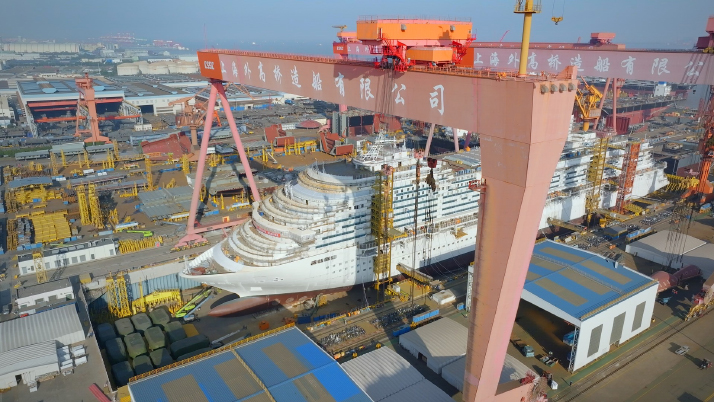The Vista-class ship has a gross tonnage, or the measure of a ship’s overall internal volume, of 135,500 tons, a length of 323.6 meters and a width of 37.2 meters. With a height of 70 meters, the ship is almost as tall as a 24-story building.
Vista-class ships are named after a group of large cruise vessels built by Italian shipbuilding company Fincantieri S.p.A and operated by Carnival Cruise Line, a cruise company owned by Carnival Corporation & plc, a cruise operator based in Miami, Florida.
In the shipbuilding industry, luxury liners are considered one of the most challenging vessels to build due to their high standards of design, craftsmanship, operation and management. And for a long time, this had been the one high-value-added and hi-tech vessel type China was not yet ready to tackle.

Perfect timing
Like many Chinese, Chen Binyi, Deputy Director of the SWS cruise ship interior design department, first saw an ocean liner in James Cameron’s Hollywood blockbuster Titanic, which premiered on the Chinese mainland in 1998. He was impressed by the lavish design of the ship in the movie, which replicated the original ship with the help of computer-generated imagery. It wasn’t until eight years later, in 2006, that Italian company Costa Cruises became the first international company in its sector to operate regular cruises in China. Operations began in July 2006 with the Costa Allegra, featuring a passenger capacity of 1,000, operating round-trip voyages from Shanghai. In a little over six months, the ship served 18,000 Chinese tourists.
Other cruise companies such as Royal Caribbean Cruises Ltd. and MSC Cruises soon followed suit and China’s cruise tourism industry experienced explosive growth for almost 10 years. Before the COVID-19 pandemic, the country’s cruise market had become the world’s second largest, right after that of the U.S. The booming market had pushed up Chinese demand for luxury liners and global production capacity proved inadequate to meet it.
Large shipyards in Europe are the main builders of giant ships such as the luxury liners. As of August 2019, Italy’s Fincantieri S.p.A., Germany’s Meyer Werft and France’s Chantiers de l’Atlantique had fulfilled more than 90 percent of the world’s cruise ship orders. According to Qianzhan Industry Research Institute in Shenzhen, Guangdong Province, Europe’s annual production capacity of cruise ships with gross tonnage of above 70,000 is about eight while the global demand is around 15. In sum, supply falls desperately short of demand. “It’s the right time to develop domestically made large liners,” Li Jianing, a designer of China’s first homegrown cruise ship and Director of the SWS development department, told China Newsweek magazine.
In October 2013, China State Shipbuilding Corporation Limited (CSSC), the largest shipbuilder in China, embarked on the homemade luxury liner project and opted to team up with Carnival Corporation & plc.
SWS is a wholly owned subsidiary of China CSSC Holding Ltd., a publicly listed company controlled by CSSC.
In 2017, CSSC signed a memorandum of agreement (MOA) with Carnival Corporation & plc and Fincantieri. According to the MOA, CSSC and Carnival Corp & plc would establish a joint venture which would then place an order for two Vista-class vessels with a cruise shipbuilding joint venture to be established by CSSC and Fincantieri. Each ship carried a price tag of $750 million.
In November 2018, CSSC and Carnival Corp & plc then formally launched their joint venture CSSC Carnival Cruise Shipping Ltd. Also in November 2018, CSSC and Fincantieri established the separate joint venture to provide technical and project service support to SWS throughout the shipbuilding process. The order for the two vessels was placed and the building of the first started in October 2019 accordingly.
A mighty mission
“It’s not difficult to make a hull. What is challenging is to build a moving city on the sea—a ship which incorporates the functions of a city,” Chen told China Newsweek. A luxury liner not only needs to brave storms at sea but also needs to have basic functions such as water and power supply and waste disposal. It also needs to satisfy the needs for entertainment and leisure of more than 5,000 people on board, he added. “Realizing all these miscellaneous functions within a limited space is a huge and complicated project,” he said.
The cruise vessel consists of 25 million components and parts, five times that of China’s first domestically developed narrow-body passenger jet, the C919, and 13 times that of Fuxing, China’s first self-designed bullet train.
Despite this huge number of components and parts, a cruise ship comes with exceedingly strict weight requirements. The first domestic one of its kind has a weight of 65,000 tons. A deviation of several hundred tons, or less than 1 percent of the ship’s weight, is allowed during construction. Every ton of increase in the vessel’s weight means a lower number of people and materials can get on board, which in turn means a loss of (potential) profits for shipowners.
To reduce weight from the source, the cruise ship uses a large number of steel plates with a thickness of 4 to 8 mm. The plates are light but pliable. To process such plates, SWS established a smart manufacturing workshop that uses laser cutting and welding technologies to improve the efficiency and accuracy in the transportation, cutting and processing of these plates.
On December 17, 2021, the ship was floated out at the SWS shipyard, bringing it another step closer to the sea.
Construction of the second domestically built large liner started in August last year, indicating China has mastered the core technologies in designing and building these giant ocean palaces.
Over 91 percent of construction on the country’s first luxury liner had been completed as of February.
The ship is set for completion by late May, with its first trial voyage scheduled for July. It will sail under the brand name Adora Cruises, which was unveiled by CSSC Carnival Cruise Shipping Ltd. in November last year.
The vessel will provide its passengers with state-of-the-art shopping and entertainment experiences. It will have a 2,000-square-meter shopping complex, the largest of its kind at sea in China. And it will also have a duty-free shopping center. It is expected to be the world’s first cruise ship with complete 5G coverage, offering guests broad multimedia access.
In February, Adora Cruises announced an agreement with Chinese comedy and drama production company Kaixinmahua Cultural Tourism Development Co. Ltd., also known as Mahua FunAge, to create the country’s first live comedy theater at sea. Mahua FunAge will present two comedy-drama shows onboard Adora liners—one in a formal grand theater and the other in a more casual bar setting. –The Daily Mail-Beijing Review news exchange item






